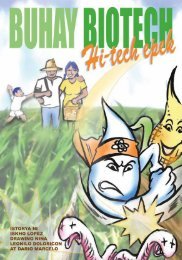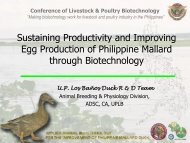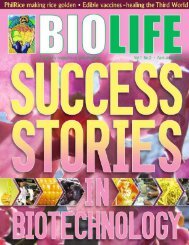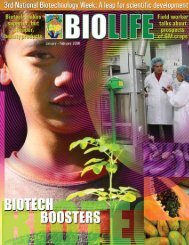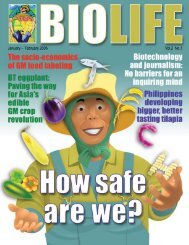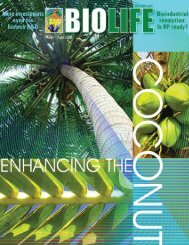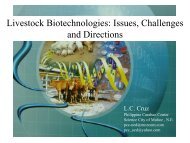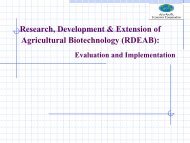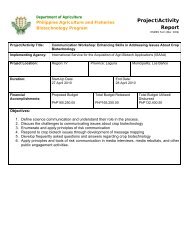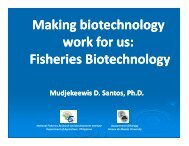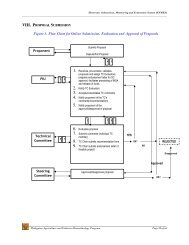Download PDF - SEARCA Biotechnology Information Center
Download PDF - SEARCA Biotechnology Information Center
Download PDF - SEARCA Biotechnology Information Center
You also want an ePaper? Increase the reach of your titles
YUMPU automatically turns print PDFs into web optimized ePapers that Google loves.
January – March 2005 BIO LIFE<br />
27<br />
logy and food security<br />
schooling ranges from two to 20 years, with<br />
many of the poor having at most four years<br />
of primary education. “In short, conditions<br />
are so variable,” says Halos. “It is folly to<br />
provide a single solution to problems of<br />
low productivity which, in general, characterize<br />
Philippine agriculture.<br />
Hence, we believe that biotechnology<br />
is only one of the technological means to<br />
increase incomes.”<br />
She cites as an example the organic<br />
produce market, where products are<br />
priced about twice as much as the nonorganic<br />
ones. “Depending upon market<br />
conditions, income increases can be<br />
achieved by targeting a niche market,” she<br />
continues. “This market is limited to<br />
the higher-income bracket (5 percent<br />
of the Philippine population) and<br />
accessible to farmers mainly around<br />
urban centers.”<br />
Organic farming incurs higher<br />
production cost and lower yields due<br />
to insect pests and diseases, which<br />
today are not reliably controlled by<br />
organic means. Halos likewise<br />
underscores that there is lower<br />
efficiency in organic farming owing to<br />
these factors. “Besides, tropical<br />
conditions breed so many insect<br />
pests and diseases,” she says.<br />
Another means to increase incomes is<br />
to increase yields per unit area. A dramatic<br />
example is the use of hybrid corn compared<br />
with traditional varieties introduced<br />
by the Spaniards centuries ago. Hybrid<br />
corn yields range from 3-9 tons/ha<br />
whereas traditional corn varieties yield 0.3-<br />
2 tons/ha.<br />
On the other hand, income increases<br />
can be achieved by preventing losses<br />
mainly from pests and diseases. These<br />
losses range from 35-100 percent. In corn,<br />
reports on yield losses due to the insect<br />
Asiatic corn borer range from 5-95 percent.<br />
Currently, farmers control this insect<br />
with a chemical pesticide applied by hand<br />
into individual plants. This chemical can<br />
cause nausea and vomiting among the<br />
applicators, death to farm animals, and<br />
can kill any insect species that encounters<br />
it. Moreover, for the chemical to be<br />
effective, it must be applied at a particular<br />
time within a short period during corn<br />
growth.<br />
“Farmers are therefore looking for a<br />
better solution to the borer problem,”<br />
continues Halos. Multi-location trials<br />
conducted with the genetically modified Bt<br />
corn have conclusively shown that the<br />
borer cannot thrive on Bt corn and yield<br />
gains averaged 40 percent. Bt corn is<br />
genetically modified to include a toxinproducing<br />
gene from a soil bacterium,<br />
Bacillus thuringiensis, which poisons<br />
insects feeding on the plant. “For this<br />
reason, planting Bt corn has become<br />
attractive to many farmers who don’t mind<br />
paying for the seeds because they beleive<br />
that their increase in yields will compensate<br />
for the additional seed cost,” says<br />
The increasing hectarage<br />
of GM crops (from 1.6 million<br />
in 1996 to some 50 million<br />
the past few years) implies<br />
that an increasing number of<br />
farmers see more benefits<br />
from planting these crops.<br />
Halos. “If provided credit, they will buy<br />
good seeds and, once they enjoy the<br />
benefits of assured higher yields, they<br />
would rather buy good seeds and reject<br />
seeds of dubious quality even if provided<br />
free.”<br />
The increasing hectarage of GM crops<br />
(from 1.6 million in 1996 to some 50 million<br />
the past few years) implies that an<br />
increasing number of farmers see more<br />
benefits from planting these crops.<br />
Reports from South Africa and China show<br />
that small farmers benefit more from the<br />
technology than corporate farmers.<br />
“I agree that biotechnology research in<br />
developing countries should focus on<br />
solving technical problems of each<br />
country’s agriculture,” says Halos.<br />
“In addition, research should also<br />
address biosafety issues including setting<br />
up the necessary infrastructure to comply<br />
with biosafety regulations. That is, when a<br />
country decides to invest in biotechnology<br />
research it should also establish biosafety<br />
regulations. In this manner, issues raised<br />
against biotechnology are scientifically<br />
addressed. Although this raises the cost of<br />
the technology, it does provide assurance<br />
to the public that proper measures are<br />
adopted to ensure that biotech products<br />
are safe.”<br />
According to Halos, the Philippines has<br />
adopted biosafety regulations covering<br />
biotechnology research since 1991 and<br />
has recently established regulations<br />
covering the import, commercialization and<br />
release into the environment of biotech<br />
plant and plant products. These regulations<br />
define the biosafety research agenda<br />
in developing a biotech crop.<br />
Halos also cites research on<br />
edible vaccines for humans as well as<br />
animals. “The development of edible<br />
vaccines is undertaken primarily by<br />
researchers in industrialized countries,<br />
supposedly for developing<br />
countries,” she explains. “To hasten<br />
this development, it is about time that<br />
we in the developing world actively<br />
participate in developing the effective<br />
edible vaccine for our own country<br />
needs.”<br />
Dependence on agricultural<br />
products makes Asian needs unique<br />
to the region when compared to the<br />
more developed countries in the western<br />
hemisphere.<br />
China is keen about adapting the use<br />
of Bt crops just as India is moving towards<br />
its utilization and other Asian countries are<br />
carefully watching and looking forward to<br />
its use.<br />
The continuing research and development<br />
of agricultural biotechnology is in<br />
preparation for the challenge of food<br />
security in the future.<br />
(Dr. Saturnina Halos provides advice to the<br />
Philippine Department of Agriculture on biotechnology<br />
for agricultural development. She<br />
was trained as a plant breeder and geneticist<br />
and has been doing research in biotechnology<br />
for years. Using public funds, Dr.<br />
Halos and her husband have invented and<br />
are developing the market for a microbial<br />
preparation—a seed inoculant—that improves<br />
plant growth and yield and reduces<br />
fertilizer requirements. She’s also doing research<br />
using DNA analysis.)




